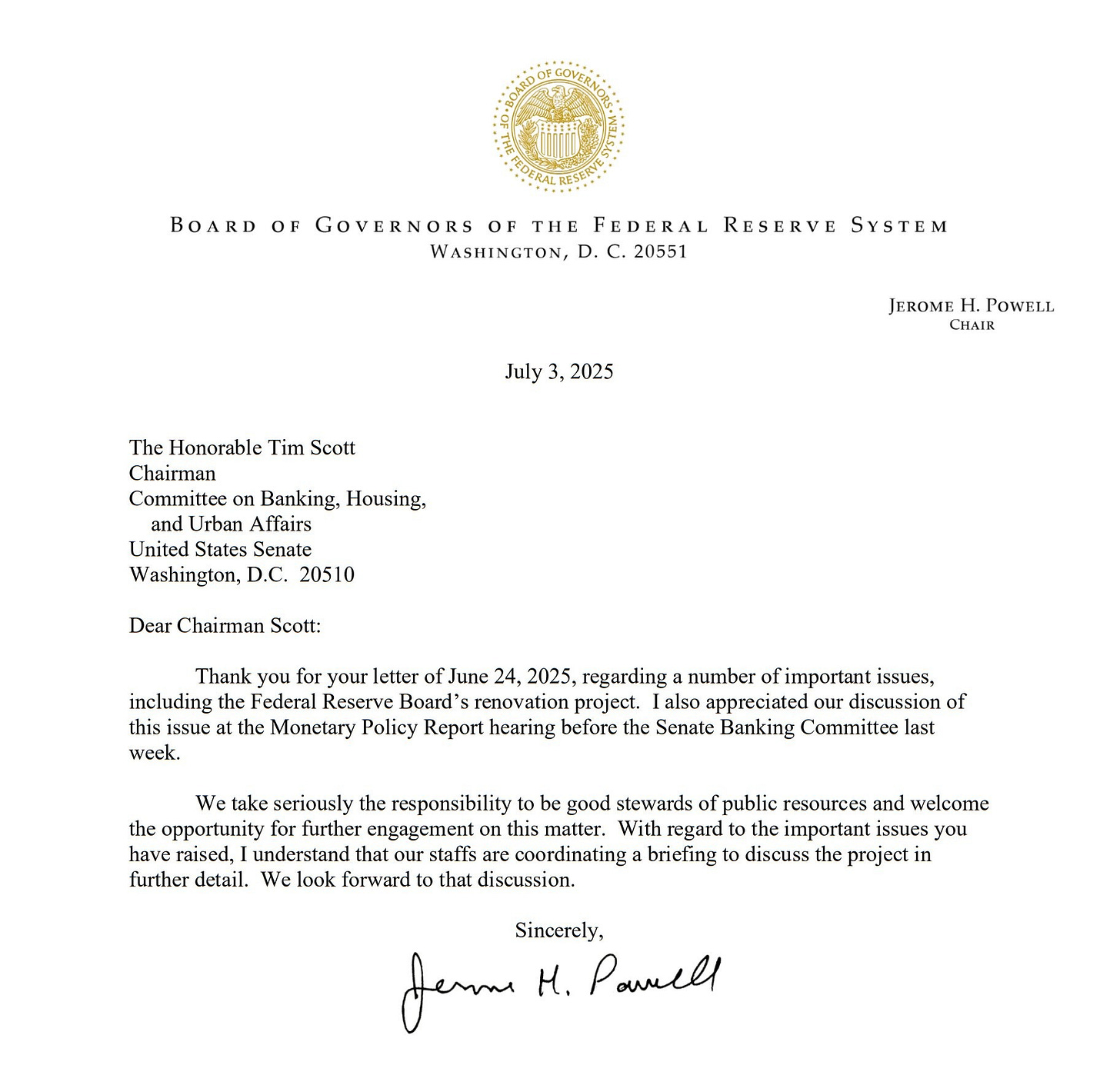Glass Houses, Glass Atriums
How the Fed’s $3 Billion HQ Renovation Exposes the Need for an Independent Inspector General

On June 25, during the Federal Reserve's semiannual Monetary Policy Report to Congress, Chair Jerome Powell was questioned by members of the Senate Banking Committee about the escalating costs of the Fed's headquarters renovation project. In response, Powell described media reports on the renovations as “misleading and inaccurate in many, many respects,” asserting that features such as VIP dining rooms, special elevators, water features, and rooftop gardens were not part of the current plans. However, planning documents submitted to the National Capital Planning Commission (NCPC) in 2021—documents that have not been revised—appear to contradict these claims. Shortly thereafter, economist Andrew Levin documented these discrepancies here on FinRegRag.
Since then, the situation has escalated considerably. Senator Cynthia Lummis told the NY Post that Powell “made a number of factually inaccurate statements to the Committee” and “should be embarrassed.” Federal Housing Finance Agency (FHFA) Director Bill Pulte issued a press release calling for Congress to immediately investigate Powell over alleged “political bias and deceptive Senate testimony,” conduct Pulte argues is sufficient grounds for Powell to be removed “for cause.” On July 3, Chair Powell responded in writing to a June 24 letter from the Senate Banking Committee, which pressed Powell for details on “lavish renovations.” Powell agreed to a meeting between Federal Reserve and Senate committee staff to discuss the project, emphasizing the Fed's commitment to being “good stewards of public resources.”

Some may dismiss this controversy as little more than palace intrigue, but it highlights a deeper underlying issue. While it’s a positive development that the Fed Chair has agreed to provide more details to Congress, the Fed never should have found itself in this position in the first place. With more effective oversight—such as a truly independent inspector general (IG)—costly design decisions, like glass atriums and rooftop terraces, likely would have been flagged and curtailed early, to the benefit of taxpayers.
The public's insight into these renovation expenses comes not from intentional transparency, but a quirk of geography. Because the Fed’s headquarters—the Eccles Building and the adjacent FRB-East Building—sit directly on Constitution Avenue, the Federal Reserve was legally required to disclose and obtain approval from the National Capital Planning Commission (NCPC) and the Commission of Fine Arts (CFA). These agencies oversee compliance with federal planning requirements, historic preservation laws, environmental impacts, and architectural consistency. Had these mandatory disclosures not occurred, the public—and Congress—might still be in the dark.
True Stewardship Necessitates Oversight
As the nation’s central bank, the Federal Reserve is one of the most powerful institutions in the federal government. Unlike most agencies, the Fed operates with an extraordinary degree of autonomy: It sets its own budget, owns its own buildings, pays staff under its own compensation system, and is exempt from the normal congressional appropriations process. Its Inspector General is not an independent, Senate-confirmed official like those at other major agencies. Instead, the Fed’s IG is appointed by and reports directly to the very institution it is supposed to oversee. Meanwhile, Congress’s main watchdog, the Government Accountability Office, is legally restricted from reviewing most of the Fed’s operations. This insulated structure is meant to protect the Fed from short-term political pressures, especially when it conducts monetary policy.
But independence in monetary policy does not justify a complete lack of accountability. Congress is the Fed’s boss. Congress created the Federal Reserve and retains full constitutional authority to oversee how the central bank uses its power and resources.1 Until recently, the only external oversight of the Fed’s headquarters renovation came from planning commissions primarily concerned with aesthetics and zoning, not stewardship of public resources. While Congress has now, rightly, begun asking questions, that oversight is reactive when it should be routine.
If the Fed wants to maintain its independence, it must first earn and sustain public trust through genuine transparency—not only in monetary policy, but also in governance and fiscal stewardship. Congress has both the authority and the responsibility to ensure that the Fed does just that.
The Case for an Independent Inspector General
As Levin has argued, the Fed should welcome the appointment of a Senate-confirmed IG who answers directly to Congress. Such an IG would ensure genuine accountability and transparency, reinforcing, not undermining, the Fed’s institutional independence. Other leading central banks have embraced this model. The Bank of England, for example, has established an Independent Evaluation Office that reports to its oversight board and has invited external reviews of its policy framework. In practice, accountability can actually protect independence, not undermine it.
A truly independent IG would have the authority to conduct comprehensive reviews of the Fed’s operations, including spending decisions, staffing practices, building projects, and internal governance. This authority would not involve second-guessing monetary policy, but would ensure regular, public accountability for how the Fed manages its resources. As Levin notes, every major federal agency with a comparable budget already has such an IG. The Fed should be no exception.
True stewardship of public resources requires more than good intentions. An independent IG would be a meaningful step toward structural accountability, helping to ensure taxpayers never again foot the bill for palatial-inspired water features and private rooftop dining rooms.
[U.S. Const. art. I, § 8, cls. 5, 18.]


